The
National Wildlife Federation has created an extremely cool
searchable wildlife database. It allows you to search by
critter or even lists the wildlife in your area. A photo
and fairly detailed description of each animal is provided:
For
the Sierra Biozone.
The
eNature.com guides to plants and wildlife.
iNaturalist.org is a new site that allows you to post any natural
history observation (wildlife, mushrooms, plants) by location
and link it to a photo (if you have one) on Flickr and other
photo sites.
Field
Notes:
February 2010:
Submitted by Matt Banta of Lee Vining.
White
Tailed Ptarmigan
Attached
are some photos of White Tailed Ptarmigan, Lagopus eucurus, we
came across in January of 2008. I believe this is an introduced
species of birds to the Sierra Nevada but not sure. They are
a bit rare and hard to find so I get a bit excited to see them.
There are two populations that I am aware of, one in the Lundy
Canyon/20-Lakes Basin area and one in the Virginia Lakes area.
These birds were found above Virginia Lake although last weekend
I found a lot of ptarmigan sign at the 9-10,000 ft elevation
on the east slope of Dunderberg Mt. They are a very interesting
bird and very neat to see in the winter.
Editor's
note: They were introduced by California Department of Fish
and Game to the Sierra in 1971/1972 and have expanded slowly
north and south near Lee Vining, California.
I've seen them as far south as the east side of Bishop Pass in
March.
June
3, 2007: Submitted by Nate Stephenson, USGS Research Scientist,
Sequoia and Kings Canyon National Parks. (Events
took place May 27, 2007, give or take a day).
Two
Foxes and a Bobcat: a Foothills
Drama
Through
the open bedroom windows, I heard a load, insistent, and familiar
sound approaching: “AAAOoow! AAAOoow! AAAOoow!” It
had a guttural quality – as if from a throat clogged with
phlegm – mixed with an eerie “voice” vaguely
resembling a human scream. My wife and I often hear the
sound around our house in the rolling blue oak woodlands near
the North Fork of the Kaweah River, but we’ve never identified
its creator. Usually the sound comes during the dark of
night, and whatever creature makes it melts away at the first
sign of our approaching flashlights. But at 5:45 a.m. on
this Memorial Day weekend, there was plenty of light. I
leaped up and ran to the window.
A
bobcat was walking along, shoulders rolling in graceful feline
fashion. But the bobcat wasn’t making the sounds. Instead,
its ears were pointed back at the source of the ruckus: one
of a pair of gray foxes following about 15 feet behind. The
foxes trotted parallel to one another, separated by a few feet. Their
tails were raised about 45º where they left their rumps,
then swept gracefully down and back. The fox closest to
me continued to yell at the bobcat, “AAAOoow! AAAOoow!”
Continued
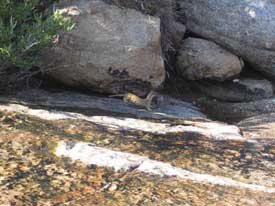 |
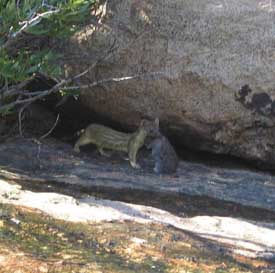 |
Lunch time for
a Long Tailed Weasel in Yosemite |
This was submitted by "SnowNymph" who was hiking up Rafferty Creek
out of Tuolumne Meadows in Yosemite National Park on July 24, 2004:
"We heard a high pitch scream, looked back, and saw
a small weasel with a fat pika in its mouth, almost bigger than
the weasel. The pika was squirming, and the weasel shook it back
and forth until the pika quit moving. Then it looked at us, and
ran away with the pika in its mouth. I only had time to take
two photos, but you could see how vicious this weasel was by
the look on its face."
A
zoologist from UC Berkeley believes the prey might be a vole
instead. Note the relative size of prey vs. predator. I once
watched a weasel drag a vole, which was over half its weight,
for about 3 hundred meters. The weasel would run forward about
5 meters with the vole dragging between its front legs. It
would then stop and breath for a few, then repeat. It saw me
watching from only a few meters away, but seemed unconcerned
by my presence. Like many members of that family (Mustilidae)
they're very curious animals and I've often had both weasels
and pine martens come closer to me to see what I'm up to.
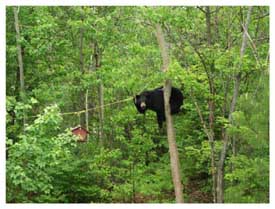 |
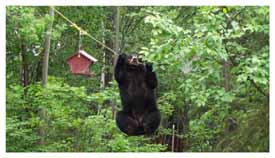 |
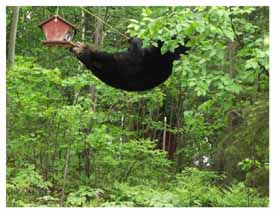 |
 |
Smarter
than the average bear? Actually, probably not. This is
why bear cannisters and metal boxes are the only things
keeping your food safe nowadays!
(photographer and location unknown.) |
Hi George,
Attached is a photo I took at about
7:30 PM on June 8, 2004, under planted shrubbery bordering
the parking lot on the south side of the NPS maintenance building
in El Portal, on the NPS administrative site. This juvenile
leucistic Western Scrub Jay (Aphelocoma californica)
had been reported right outside the dispatch office for about
three days prior. The bird was still with a family group with
at least one other fledgling, and the parents were feeding
them. The white bird could fly fine. This night it was observed
by me, Mike Osborne and Nancy Pimentel. (I know, this group
makes the whole thing seem suspect. It really happened. Honest.)
Reading
on leucisism in birds on the internet points out to me that
there is little agreement of terminology between leucisism,
partial albinism and incomplete albinism. There seems to be
varying degrees of leucism; this bird would be at the extreme
end of the scale. So, my using the term leucistic may be questioned.
The bird appears to have dark eyes in the photo, although it
was under a bush and there may not have been much light to
reflect to show pink eyes. None of the other photos showed
pink eyes, even on the pavement in the open. (I was so busy
trying to photograph the bird that I did not study it at the
time with binoculars.) Because the eyes are dark, I don’t
think it would be correct to term it a full albino. The bill
and legs seem to be colorless, just to confuse the issue.
Anyway,
I thought it was pretty cool! I haven’t found anyone that remembers seeing a white
jay around here in the past. I did find a photo of a white
Steller’s Jay posted on the internet on a Tehachapi birding
site.
Thanks.
Dan Horner
P.O. Box 806
Yosemite, CA 95389
dan_horner@nps.gov
5/04:
From
wildlife photographer John Senser of Golden Oak Studios:
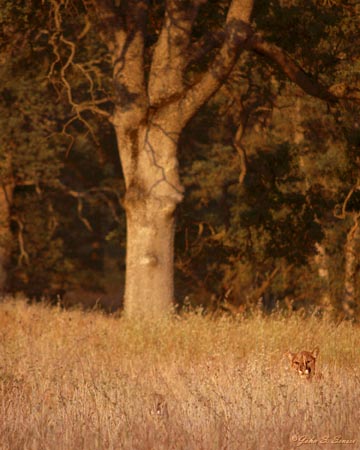 |
Two
(!) Mountain Lion in afternoon light. This is why they're
so rarely spotted by hikers.
Tuolumne County, CA Photo© John
Senser |
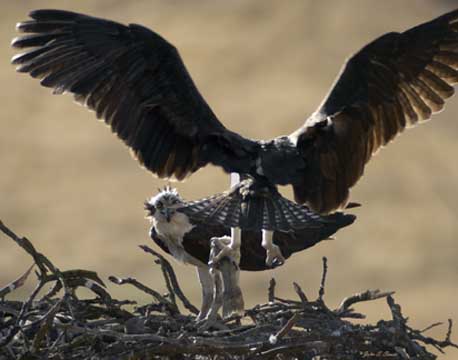 |
Osprey with dead fish coming in to feed two young as
mate watches (look very closely to spot the young).
Tuolumne
County, Ca. Photo© John Senser |
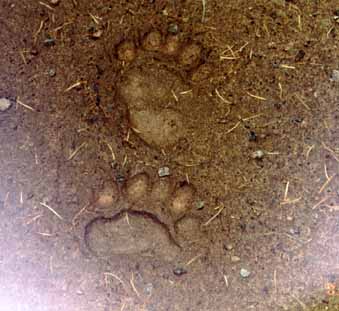 |
Excellent example of the front and back paw prints of a
Black Bear. Top print: left hind. Bottom: left front.
Photo: © Joseph Migler |
|
Species: |
Black
Bear (Ursus americanus) tracks. |
| Location: |
Chowchilla
Mountain Rodad near Big Creek and Mt. Savage; near Wawona
in Yosemite National Park. |
| UTMn |
11S 4156200 |
UTMe |
264440 |
| Observer: |
Joseph
Migler, Laura & Julio Tellez |
Date: |
November
8, 2003 |
Editor's
Note: We're
not always lucky enough to see the actual critters in the woods.
That's why you want to look down occasionally
and
see
what
tracks and scat have been left as clues to who's around.
Dear Sierra Nature Notes:
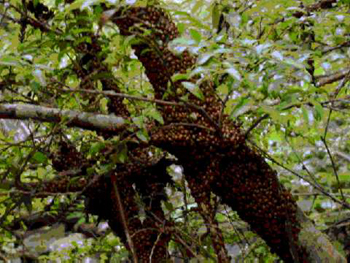 |
| Lady
bugs (Hippodamia
Convergens) congregate in Muir Woods
National Monument. |
This
past weekend, my family and I enjoyed a lovely vacation, staying
at the Wawona Hotel (a
family tradition,
this
is our
13th year!). As we were hiking along the Swinging Bridge
Trail (Monday, November 10, 2003 in the morning) near Wawona,
we spotted thousands of ladybugs on some ground cover and small
shrubs
just off the
trail. We were curious as to what they were doing. Thank
you
for your very informative Sierra Nature Notes!
Sincerely,
The Migler Family (Anthony, Regina, Theresa and Joseph)
Dear Migler Family:
How cool! Fall visitors to Yosemite often come across ladybug
swarms above Happy Isles in the fen there or along the river
in Wawona. They're swarming in a relatively
warm and protected spot to hibernate for the winter.
Deer
Whisperer
Peter Stekel
Editor's
note: kids (and adults!) – don't try this at home. Peter's
very experienced with wildlife and willing to take the chance.
Every year, though, people receive serious injuries from getting
too close to deer and other wildlife, thinking them tame. They're
not. They're wild animals and even a gentle looking deer can deliver
a serious or fatal injury from a hoof strike. Always keep a safe
distance from all wildlife.
Everybody
wants to see wildlife. Unfortunately, few have the patience to
sit and wait — but that is just what it takes. The good news
is that there's no particular skill involved in watching wildlife.
Cars, for instance, are natural "blinds" and make excellent
wildlife observatories. Just sitting for an extended time at the
edge of a meadow or by a stream is another great way to see critters.
A friend of mine, though, started me on a completely different
quest – getting very close to deer. A major goal of his has
been to stalk a deer, then touch it.
Continued
An
Unexpected Meeting
Erika
Jostad
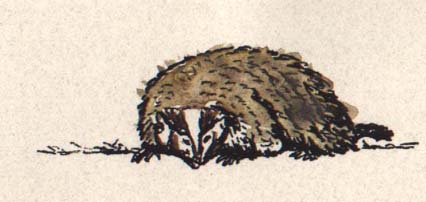 |
| Watercolor
© Erika Jostad 2001 |
We met on a clouded afternoon along the John Muir Trail near
Crabtree Meadows. In the absence of shadow, I could see far into
the lodgepole/foxtail pine forest rimming Sandy Meadow as I strolled
north. Ahead, I spotted an awkward coyote hop a log then get on
the trail coming my direction.
Continued
Buzz-worms
of the Southern Sierra
Jim Warner
I've walked the trails of the Southern Sierra for many years,
and have seen a good many "buzz-worms," as one former
Kings Canyon ranger occasionally calls rattlesnakes. Folks tend
to think of rattlesnakes as denizens of low elevations, maybe
up to about 6,000'. In the southern Sierra, they are found at
elevations up to 11,000'. One was even found near the top of
Alta Peak (11,204') in Sequoia National Park. Continued
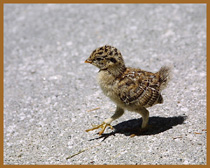 |
Blue
Grouse chick (Dendragapus obscurus).
Photo:
© Benjamin
R. Miller |
Volunteer's
Luck
Pete
Clum
My
first trip as a backcountry volunteer in Kings Canyon National
Park was an especially rewarding wildlife experience and just
shows what marvelous critters await the lucky Sierra hiker. My
first day, I hiked from Cedar Grove to Junction Meadow at about
8,000 feet. When I reached the meadow, I walked out into it and
spotted a medium size cinnamon colored bear munching the grass.
At first the bear was unaware of my presence. Upon sensing me,
he ran several hundred feet to a spot by the creek and picked
up a dead fawn and started to eat it. Within a few minutes however,
he snatched up the fawn and ran off into the trees. Continued
|
Species: |
Red
Crossbill (Loxia curvirostra) |
| Location: |
Sky
Parkor Meadow, Sequoia National Park. |
| Habitat: |
Lodgepole
forest |
| Observer: |
Rob
Hayden |
Date: |
August
2000 |
Imagine
treeline in the high mountains, the Kaweah Range in Sequoia National
Park as a backdrop, miles and miles of mixed lodgepole and whitebark
pine. Up in the high branches, hearing a sweet, delicate
chirp ("chirp-chirp" – pause, undulate –
"chirp-chirp", again); a plump shape smaller than a
robin, moving through the tree – from cone to cone –
just a silhouette, not sure the color – was it just a shadow?
But then: there are more of ‘em swarming over the branches,
clinging as they tear at the lodgepole cones with their strange
beaks. Small flakes of cone float to the ground.
Continued
|
Species: |
Fisher
Martes pennanti Family Mustelidae |
| Location: |
East
Fork Kaweah River, Sequoia National Park |
| Observer: |
Liz
van Mantgem |
Date: |
4/2001 |
Winning the Fisher Lottery
Last April (2001), I saw a fisher for 10 whole minutes. That's an
eternity in the realm of wildlife viewing, and it could have been
longer if I'd only had more nerve. She (or he) dodged past as I
hiked to the East Fork of the Kaweah River. Surprising me, after
I scared her first, the fisher crashed through the adjacent shrubbery
and leaped into a big oak tree. It was the only big tree in the
scrub, so she was stuck on a fat limb, sinuously pacing and waiting
for me to leave. Continued |